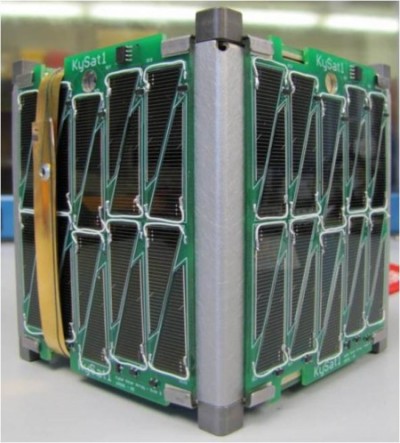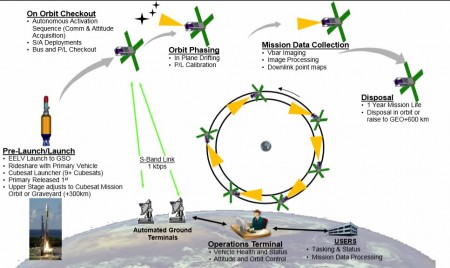April 13, 2015 – In the recent NextSTEP announcements at NASA two partners were awarded contracts for cubesat development. They are Morehead State University and Lockheed Martin Space Systems Company. Talk about very different partners. Morehead is a northeastern Kentucky-based school that has had a relationship with NASA for some time. It offers a space science bachelor’s degree, and includes an on premises space tracking system and research centre. Lockheed Martin on the other hand is one of the largest of NASA’s commercial partners and is heavily involved in logistical support and product development for the space agency. Both have received one of the 12 NextSTEP partnership contracts in the category entitled “cubesats.”
So what is a cubesat? Cubesats are to space what smartphones are to telecommunications and Internet access. These small satellites are democratizing access to near-Earth orbit. You can even go online and purchase your own cubesat kit. In a world where we are creating an Internet of Things we have witnessed explosive growth in miniaturized devices. Cubesats are the beneficiaries of this revolution.
Typically you can build a cubesat within a framework no bigger than a 10 centimeter cube (think less than 4 x 4 x 4 inches), weighing no more than 1.33 kilograms (less than 3 pounds). If you need something bigger you can stack cubesats like building blocks and inside each pack commercial, off-the-shelf components containing sensors, processors, cameras, data storage and software. Because they are small and weigh so little the cubesat you create could be added to planned rocket launch carrying a much larger primer payload, riding along as shotgun.
The downside of cubesats is durability and longevity. They really aren’t, as of yet, meant for long missions. Typically they don’t carry onboard propulsion technology (fuel adds weight). But take the components of your smartphone and put them into a cubesat and you can deliver a pretty powerful little satellite that could probably gather a few days of data including high resolution imagery and communicate it back to you. And do all this for about $8,000 U.S. including all your materials and fabrication. I suspect that price will even be less in years to come.
But getting back to the NextSTEP announcement by NASA involving Morehead and Lockheed Martin, these two are to deliver cubesat payloads for launch in 2017 or 2018 on board NASA’s new heavylift rocket, the Space Launch System (SLS). NASA has room for 11 cubesats on this first SLS flight. Three are being developed by NASA and other U.S. government branches. Morehead is specifically tasked with designing and delivering a cubesat (similar to the one seen in the image below) that will prospect for water ice on the Moon. Called the Lunar IceCube, the cubesat will reside in a ring-like adapter connected to the Orion capsule mounted on top of the SLS. It will be spring-ejected into a low-perigee lunar orbit 100 kilometers (62 miles) above the surface.This will be the first time a cubesat is deployed into Deep Space. Lockheed Martin’s contributing mission is currently not described anywhere in the literature.
But Lockheed Martin is big into cubesat technology. The company proposed in 2013 to use cubesats to improve space situational awareness (SSA) for the United States. SSA refers to the current congestion caused by the number of objects in orbit around our planet. The rising risk of collision between satellites launched by many providers is of great concern to the U.S. space agency. It seems with increasing frequency we hear that on board the International Space Station, the crew has to take emergency precautions as NASA tracks incoming space junk. In some cases the crew have been instructed to alter the orbit of the ISS to move it out of the way of orbital debris. It may sound counter intuitive to more stuff into orbit to track stuff in orbit but Lockheed Martin believes cubesats present the best answer providing depth of coverage in tracking all objects in both low-Earth and geostationary orbit (see image below from 2013 study of the problem).
In any case NASA is confident that cubesats are the future of satellite technology, able to observe and collect data for a fraction of the cost of larger, heavier and more complex satellites. For the rest of the world cubesats represent a paradigm shift in our ability to access space and we should see explosive growth for national space and private space research programs in the coming decades as more of these small satellites are deployed.











[…] The end of the year space station delivery mission would be the first for Orbital ATK since an Oct. 28, 2014 launch mishap at NASA's Wallops Island, Va., Flight Facility. [3] Three additional payloads will be determined through NASA's Cube Quest Challenge – sponsored by NASA's Space Technology Mission Directorate and designed to foster innovations in small spacecraft propulsion and communications techniques. [4] From the early days of Project Mercury to the Space Shuttle Program and International Space Station, from the Hubble Space Telescope to the Mars rovers, the center enjoys a rich heritage in its vital role as NASA's processing and launch center. [22] Both Orion and the SLS represent cornerstones in NASA's plans to resume missions of human deep space exploration. [3] Orlando Sentinel photographer Red Huber found the convergence of the natural world and NASA's space shuttles many times during the 30-year span of the program. [5] Lockheed Martin on the other hand is one of the largest of NASA's commercial partners and is heavily involved in logistical support and product development for the space agency. [23] […]